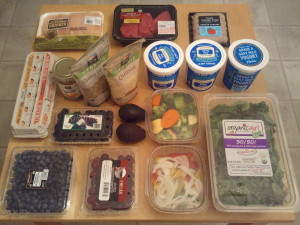 The main appeal of wellness is the improvement of all parts of life, which directly translates to better on-the-job performance. One wellness topic that has wide-ranging implications is stress. Stress can be a major factor in our lives. There will always be some form of stress, and it affects each individual to a varying degree. Interestingly enough, we can turn this into a positive and realize that stress can be an agent of change for the better. In this article, we will look at common sources of stress and how to deal with them; not only eliminating problems, but also improving lives.
The main appeal of wellness is the improvement of all parts of life, which directly translates to better on-the-job performance. One wellness topic that has wide-ranging implications is stress. Stress can be a major factor in our lives. There will always be some form of stress, and it affects each individual to a varying degree. Interestingly enough, we can turn this into a positive and realize that stress can be an agent of change for the better. In this article, we will look at common sources of stress and how to deal with them; not only eliminating problems, but also improving lives.
When can stress be productive?
Stress can be a catalyst for change. This is true whether its “life stress” you’re tired of, or deliberate stress from exercise to change your body and improve your health. By modulating or eliminating stress, you can open up more free time and clear your mind for greater productivity and enjoyment of life. Ultimately, dealing with any type of stress effectively will result in you solving a problem.
Stress and Worry
Sources of “life stress” can include the feeling of being overwhelmed, mental anguish, and worry. There’s a saying, “Worry is interest paid on a debt not yet incurred.” The overwhelming majority of the time, our worries never materialize. According to Earl Nightingale, 40% of the things we worry about never happen. 30% of things we worry about are in the past and cannot be changed. 12% of the time we worry unnecessarily about a health problem that never materializes. 10% of our worries are about various trivial things. The remaining 8% are only serious enough to concern ourselves with.
Worry is a form of indecision. It’s a way of delaying dealing with the “unknowns.” The neocortex, the logic-based executive function region of the brain, shuts down as the limbic system takes over. The limbic system is the “fight or flight” mechanism. When you feel on edge or can’t sleep when stressed out, your body and nervous system is working overtime as an emergency response- albeit in an inefficient, and irrational way of dealing with the problem.
Here is a way to address worry head-on. This method takes the worry out of the issue, and relocates it from the limbic “stress” part of the brain back to your rational neocortex. Whatever the stressful situation might be, write it down. Use your executive function. This cuts through the 1,500 words a minute the brain processes- especially when under stress. Nightingale likens this type of brain-fog to a seven-block 100 ft.-deep city fog that if collected, would not even fill one glass of water.
Now you have the issue in front of you, with greater clarity. Write down the very worst thing that could happen if the scenario you are worrying about were to come true. Would it affect your job performance, you family life, or your health? You may find it turns out to be much more trivial than these possibilities. If that’s the case, delegation and outsourcing of tasks may be the answer.
If indeed it is a serious issue that could affect your life and your job, then take action immediately on the first step necessary to overcome the challenge. Write these solution-steps down on your sheet just as you would a to-do list. This kinesthetic action, experience through physically doing, will literally implant the information into your brain so you are much more likely to follow through on it with a sense of urgency and purpose- instead of merely “knowing” you need to do it and worse yet, worrying about it. Now you can use the pent-up energy for going straight to work on the issue like a problem-eliminator, instead of letting the energy eat you alive in the form of stress. With this mindset, virtually nothing can stop you but yourself.
In addition to learning how to effectively deal with worry, the good news is that we generally worry less over the years. We realize that we’ve made it through numerous situations of varying degrees, and now the challenges do not have the promise of disaster that we once thought all but guaranteed.
Stress and Sleep
Another major source of stress is lack of sleep. Most Americans do not get enough sound sleep. It can be due to various reasons. If you suffer from poor sleep, is it because you are restless, or just that you get to bed late and have to get up early?
This can become a vicious cycle. Stress and worry can cause restless sleep, and restless sleep leads to a deepening of the situation throughout the rest of the day. The result is less productivity, presenteeism (physically present at the job but somewhat absent in mind), irritability, and health consequences. These may include poor insulin sensitivity (the way the body manages incoming dietary carbohydrates) and weight gain, which can result from the lessened insulin sensitivity, over-eating as a way to compensate, or both. Current research also shows a correlation between lack of sleep and diseases of the brain, such as Alzheimer’s and Parkinson’s, as well as a correlation with cancer and depression.
Sleep deprived individuals- as well as many people who consider themselves stressed- often have elevated resting heart rate and blood pressure. The British journal Lancet published a report in December of 2002 that found a doubling of mortality from ischemic heart disease and stroke for every 20mm/Hg systolic or 10mm/Hg diastolic increase in BP. This rate of increased risk begins with a systolic reading of 115mm/Hg.
At this point, when such symptoms have been recognized, its time to take a step back and make some changes. Otherwise, it is simply unsustainable.
“Burnout”
Its interesting how similar some of the principles of stress are in relation to exercise. Just as you may have heard of “burnout” in terms of overdoing exercise, there is a professional form of burnout known as metabolic syndrome. Metabolic syndrome is often experienced by high-achievers. Its very similar to overtraining experienced by athletes or exercise enthusiasts, as the adrenal glands have been over stimulated to the point of an inability to produce cortisol.
While cortisol is often maligned in media and advertisements for its role in weight gain, it is actually the body’s own anti-inflammatory hormone. Cortisone (the type injected for joint injuries) is the synthetic version. Like so many things, there has to be a balance. Too much cortisol results in midsection fat accumulation, as there is a concentrated amount of cortisol receptors in that area (known as visceral fat). Elevated cortisol reduces insulin sensitivity, further contributing to weight gain as well as muscle-wasting. Highly stressed individuals with elevated cortisol have less energy available for the immune system, so the body can conserve energy. When metabolic syndrome occurs, this results in a hyper-inflammatory state in the body that is ripe for disease and injury.
At this point, the cycle must be broken and stress gradually reintroduced. This occurs through changes in routine. If you are physically inactive but stressed from work or life, then gradually introduce exercise. If you are physically overactive, a complete break from strenuous activity for a number of weeks (usually two) is warranted. Reintroduction of exercise in this case would be similar to the protocol used for the stressed but physically inactive professional.
Take the weight of the world off of your shoulders
For realigning you daily activities, it comes down to management. What tasks can you delegate? All of us who are busy professionals have multiple projects we’re juggling at any given time. If it were simply possible to stay turned on like a cloud-storage data center 24/7 and keep processing information, we would most certainly knock out our projects and accomplish our goals more quickly. Being the kind of driven individuals that we are, we would probably start even more projects. Dealing with reality, we have to realize that we can only do what we can do in 16-17 hours a day and still reinvest those 7-8 sleep hours for continued success in the next day. Some things have to wait.
How do I delegate?
The first thing to do when deciding what task to complete is to ask yourself, “If I had to leave town for a month, what one thing would have to be accomplished?” Resolve to then go to work on that one task, with single-minded focus.
Another powerful strategy is to ask yourself what your time is worth per hour. Take your annual income, and divide it by 2000. This is based on a 40-hour billable workweek. Many of us put in considerably more time than that to make the 40-hour week billable! When you have arrived at your number, ask yourself, “Would I pay someone this much to complete x, y, or z?” If not, immediately delegate or outsource that task. Results through others is the definition of effective management.
Examples may include organizing a carpooling schedule with other parents at your children’s school; hiring an administrative assistant- even part time- who can also run errands for you; and hiring a personal trainer, so planning your workouts is one less thing to think about, as well as having the accountability of a paid, scheduled session.
Stress and Exercise
Exercise is a form of stress. It can also be a stress reliever. Just as there is a “balance” that we aim to achieve through wellness, there is a balance in enough exercise and too much.
There are three stages of stress in exercise. These can also be equated to other stressors in life:
Alarm or “Shock” Stage. This is when there is a new stimulus to the body. You could just be embarking on a new fitness program, or adding new types of exercises to your current program. In life, this happens with any new stimulus that requires a reaction.
Adaptation or “Progress” Stage. This is when the body is able to handle the stimulus more efficiently, such as achieving a sustained, moderate heart rate while performing a higher workload. In life, this is when we have learned to effectively handle new tasks.
Plateau or “Stagnation” Stage. This is when the body has been regularly overloaded without enough time for recovery and improvement. You can probably identify with this in life, in areas you feel overwhelmed or where there is a vicious cycle.
Just by choosing to take even twenty minutes a day, you can perform a simple activity such as walking the office parking lot to clear your mind. You will also be doing your body well by getting out of the seated position, which places 1.4 times our bodyweight on our lumbar spine.
Other activities such as swimming, running, weight training, or sports cause you to focus on the task at hand. You will be giving yourself not only the gift of improved health- be it cardiovascular, muscular strength and endurance, balance or flexibility- but you will also be allowing the stress of the day to leave your mind, like a cloud floating away in the sky.
Once you have built up sufficient stamina, you can exercise up to an hour. For achieving a balance and ensuring that you’re not causing too much stress from exercise, limit your time of vigorous activity to no more than an hour and twenty minutes, as this is when cortisol is produced in excess as an over-compensatory response.
I hope you have found this article helpful. Now you have a blueprint for moving forward in dealing with stress and gaining utter clarity on the possible challenges that may arise. You have everything you need at your disposal to take complete control of stress and put the outcome in your favor. Sometimes life’s challenges turn out to be gifts.
For more information on wellness, visit my website at lwlcoaching.com. Also see “The Three Stages of Physical Stress During Exercise” http://www.lwlcoaching.com/the-three-stages-of-physical-stress-during-exercise/.
If you would like to learn more about how to address stress in your life and tailor a program specific to you or your organization, contact Drew at drew@lwlcoaching.com, or 919-805-0520.







